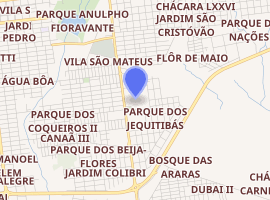Douradão
Estádio Fredis Saldívar, commonly known as Douradão, is a multi-use stadium in Dourados, Brazil. It is currently used mostly for football matches. The stadium holds 30,000. It was built in 1986.

| |
| Full name | Estádio Fredis Saldívar |
|---|---|
| Location | Dourados, Brazil |
| Owner | Mato Grosso do Sul state government Dourados City Hall |
| Capacity | 30,000[1] |
| Surface | Grass |
| Construction | |
| Built | 1986 |
| Opened | April 12, 1986 |
| Tenants | |
| Clube Desportivo Sete de Setembro Ubiratan Esporte Clube | |
Douradão is owned by the Mato Grosso do Sul state government and by the Dourados City Hall. The stadium is named after Fredis Saldívar, who donated the groundplot where the stadium was built.
History
In 1986, the works on Douradão were completed. The inaugural match was played on April 12 of that year, when Ubiratan beat Mixto 4–2. The first goal of the stadium was scored by Ubiratan's Ademir Patrício.
The stadium's attendance record currently stands at 18,780, set on July 17, 1988 when Ubiratan and Operário de Dourados drew 1-1.
gollark: concatMap, that.
gollark: First.
gollark: Which is basically just `concat . map`, but whatever.
gollark: `concatMap`?
gollark: 🌵
References
- "CNEF - Cadastro Nacional de Estádios de Futebol" (PDF) (in Portuguese). Confederação Brasileira de Futebol. Archived from the original (PDF) on October 14, 2009. Retrieved January 27, 2011.
- Enciclopédia do Futebol Brasileiro, Volume 2 - Lance, Rio de Janeiro: Aretê Editorial S/A, 2001.
This article is issued from Wikipedia. The text is licensed under Creative Commons - Attribution - Sharealike. Additional terms may apply for the media files.